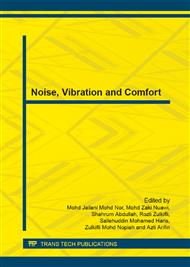p.235
p.241
p.247
p.255
p.261
p.267
p.273
p.279
p.285
Improvement of Fire Retardant Property of Natural Fiber
Abstract:
Excessive exposure to noise is harmful for human health. Noise-induced hearing loss is one prevalent disorder resulted from above case. One root solution that converts the unnecessary sound waves to dissipated heat energy is acoustic absorption panel. Previous studies had looked upon potential sound-absorbing resources corresponding to natural fiber. However, several characteristics of these biodegradable supplies such as stiffness, anti-fungus and flammability are still yet to be improved. Hence, this research was undertaken to enhance the fire retardant performance of coir fiber for the production of high quality yet low cost acoustic absorption panel. Three types of additives, borax, Di-Ammonium Phosphate (DAP), and urea were investigated to perform chemical treatment for coir fiber. Experimental measurements were executed to validate the results by referring standard of ASTM E6902 (Standard Test Method for Combustible Properties of Treated Wood) by using the Fire-Tube Apparatus. Final results showed that DAP-treated fiber has the lowest percentage loss in mass of 6.67% compared to that of borax and urea-treated fiber with values of 7.60% and 9.48% respectively. This outcome clarified that DAP-treated fiber possesses higher self-extinguishing ability. Further evaluations in term of economic values, degree of hazards against health, flammability as well as reactivity supported that DAP is the best choice since its potency was ahead of the other two chemicals.
Info:
Periodical:
Pages:
261-266
Citation:
Online since:
December 2013
Price:
Сopyright:
© 2014 Trans Tech Publications Ltd. All Rights Reserved
Share:
Citation:


